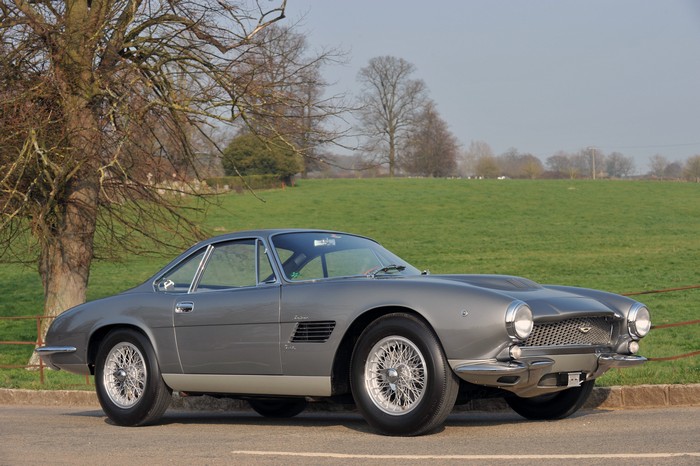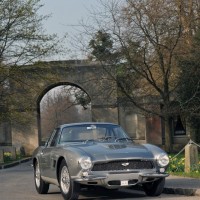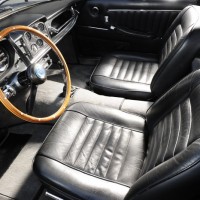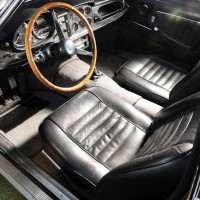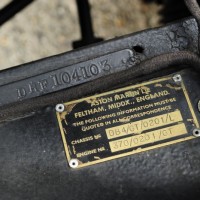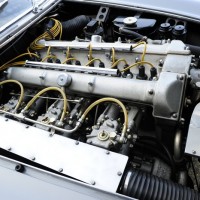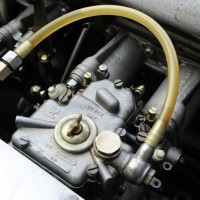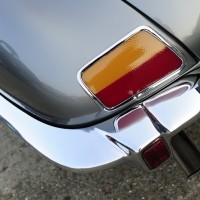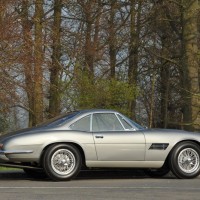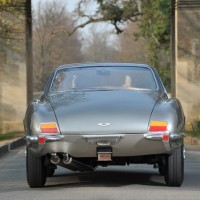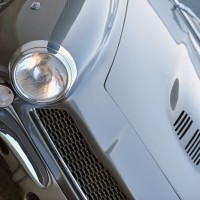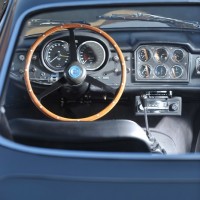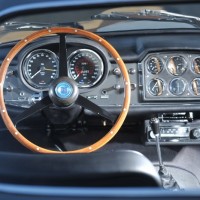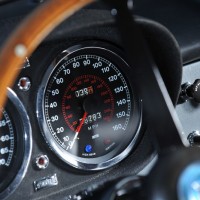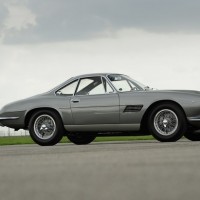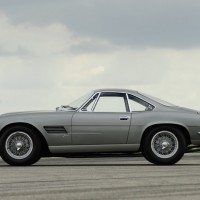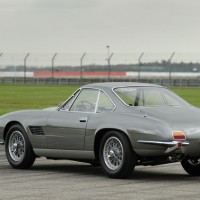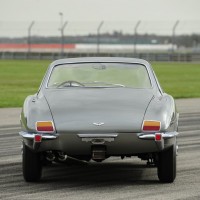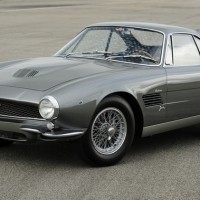Coachbuilt examples of the DB4/5/6 family of Aston Martins are extremely rare, making the unique Bertone-bodied car offered here all the more precious and desirable. Chassis 0201L is the last DB4GT chassis completed in period and was first displayed on Bertone’s stand at the 1961 Geneva Motor Show, followed by an appearance at Turin that same year.
Its designer was none other than Giorgetto Giugiaro, one of the 20th century’s foremost automotive stylists and then only 22 years of age, who would go on to create some of the Italian coachbuilder’s most memorable designs before leaving to join Carrozzeria Ghia. By the time he left Ghia to found Italdesign in 1968, Giugiaro had been responsible for such sublime creations as the Maserati Ghibli and DeTomaso Mangusta.
It was only appropriate that Aston Martin’s top-of-the range, most expensive production model, the DB4GT, was selected for this very special project. As its nomenclature suggests, the DB4GT was a competition variant of the DB4 sports saloon. Launched at the London Motor Show in 1958, the Aston Martin DB4 had emphatically demonstrated that a British manufacturer could better the Italians at their own game when it came to constructing the ultimate Gran Turismo. Its specification included a completely new steel platform chassis with disc brakes all around, and a race-developed twin-cam 6-cylinder 3.7-liter engine, all clothed in a perfectly proportioned aluminum body designed by Carrozzeria Touring of Milan. Overall, the DB4 was state-of-the-art for its time, a masterpiece of robust British engineering combined with exquisite Italian styling.
The new car’s competition potential had been recognized from the outset, and the factory lost no time in developing a lightweight version suitable for racing. The resulting DB4GT debuted at the 1959 London Motor Show. The model had already been proven in competition earlier that year when the prototype driven by Stirling Moss (DP/199) won its first race at Silverstone.
Extensive modifications to the standard car took five inches out of the wheelbase and replaced the rear seats with a luggage platform on all but a small number of cars. Together with lighter, 18-gauge bodywork, these changes reduced the car’s weight by around 200 pounds.
The GT used a tuned engine which, equipped with a twin-plug cylinder head and triple Weber 45DCOE carburetors, produced a claimed 302 horsepower at 6,000 rpm, a useful increase over the standard car’s claimed 240 horsepower. Maximum speed, of course, depended on overall gearing, but 153 mph was achieved during testing with a 0–60 mph time of 6.1 seconds recorded. The DB4 was also one of the first cars to go from standstill to 100 mph and then brake to a dead stop in under 20 seconds, a tribute, in part, to its uprated Girling brakes as used on Aston Martin’s sports racers of the era.
The DB4GT offered a strong challenge to the prevailing Ferrari dominance in GT racing, with examples entered by the Works and John Ogier’s Essex Racing Stable enjoying numerous victories. Driven by the likes of Roy Salvadori, Stirling Moss, Jim Clark and Innes Ireland, the DB4GT earned its stripes every weekend on the racing circuit. In December 1959, at the Bahamas Speed Week, Stirling Moss won driving a standard customer DB4GT “borrowed” by the Works following the demise of Moss’s intended DBR2. The DB4GT was indeed a true dual-purpose car, equally at ease on both the circuit and Grand Tour.
SCM Analysis
Detailing
| Years Produced: | 1961 |
| Number Produced: | One (out of 20 special-bodied DB4GTs) |
| Original List Price: | N/A |
| SCM Valuation: | $5.5m to $6.7m |
| Tune Up Cost: | $1,500 |
| Chassis Number Location: | Engine compartment on right of firewall |
| Engine Number Location: | Stamped on right side of engine block |
| Club Info: | Aston Martin Owners Club |
| Website: | http://www.amoc.org |
This car, Lot 239, sold for $4,939,193, including buyer’s premium, at Bonhams’ annual Aston Martin Works Sale at Newport Pagnell, U.K., on May 17, 2013.
Jamie Knight, Director of the Bonhams Motoring Department and primary auctioneer, is apt to say at slow moments — while the bidder decides whether to go the extra mile — “It’s the only one I’ve got today, sir.”
And that saying couldn’t be truer when discussing this one-off Aston Martin, still with its original engine and in near-perfect, refreshed order 30 years after its restoration.
Although the other coachbuilt cars, the 19… okay, 23… oh, all right then, 25 (and counting) officially sanctioned “real” DB4GT Zagatos are all slightly, subtly different — depending on how much wine Guiseppe and Adolfo had for lunch — they are all built to roughly the same pattern.
Thanks to its gorgeous Giugiaro styling, this one, the last special-bodied DB4GT built in period, is completely different and beautifully elegant as well — which is something Zagato couldn’t always manage.
Originally finished in light green with gray interior, the Jet, as it became known, was lavishly trimmed compared with the starker — although lighter — Zagatos.
Only 75 DB4GTs were produced, of which only 30 were left-hand drive, and this svelte notchback coupé is unique among DB4GTs not just for its shape, but as the only one bodied in steel. Unfortunately, the wind was taken out of its sails somewhat as it was at the 1961 Geneva Show — where Jaguar chose to reveal its sensational new E-type. Giugiaro couldn’t be blamed for the poor timing, but he would body only one other Aston Martin — the DB7 Vantage-based Twenty Twenty concept car of 2001.
Burned and brought back
Since 1961, this car has had quite a life — having to be completely rebuilt from a burnt wreck — but it has been properly enjoyed in its latter years while remaining in excellent condition.
Its late owner, Hans-Peter Weidmann, bought chassis 0201L from then-Aston Martin chairman Victor Gauntlett while the car was under restoration at Newport Pagnell.
Kingsley Riding-Felce, Managing Director of Aston Martin Works, recalled some of the problems in a Classic & Sports Car Magazine interview: “It was a big job because we had to make new door skins and fabricate replacement bumpers out of brass. It was quite a challenge configuring them to the body and getting the clearances right, but we wanted to keep it as original as possible. The instruments had to be redone, and searching out missing switchgear in Italy proved quite a task. The Jet was very well made and clearly built to be driven. The styling isn’t very Aston Martin, but we never tired of looking at it.”
A bit ahead of the Zagato DB4GT
There’s nothing with which to directly to compare this car, but the nearest is the DB4GT Zagato. Past sales show that a real one of those is worth about twice as much as a later-built “Sanction II” car, which corresponds with their relative values when the continuations were new. Our subject car is worth a bit more than two stock coupes — or a gnat’s more than one of the real DB4GT Zagatos.
Although this car set a world record for an Aston Martin, analyze the numbers and you’ll see that Bonhams was obviously hoping for a bit more, as the pre-sale estimate range was £2.8–3.8m ($4.5m–$6.1m), and the winning bid was one tick — $160k — over the lower number, which is often where the reserve lies.
There were initially six phone bidders up against the man in the room who eventually bought it. The buyer was described as “a European,” so it seems a fair bet the car will be leaving British shores.
This is just as well, as its Swiss registration meant that staying in the U.K. would have subjected it to a further 5% duty in import tax, which doesn’t sound like a lot, but at the £2.9m ($4.65m) bid, that’s another $225,000, which would mean the buyer would pay a total of $780,000 in premiums and duties.
Let’s not get too obsessed with the numbers, as this car’s real attraction lies in putting rubber on the road.
Meant for the road
This is a gorgeous car that’s meant for driving. Almost uniquely for a regular concours-winner car, it has been driven regularly. It wore just the right amount of tiny nicks in the paint and polish marks in the chrome to show it’s been enjoyed, and the seat leather was just settling in nicely, perfectly complemented by a delightfully bestickered trunk on the rear deck as a rolling record of its destinations.
Apparently the new owner plans to keep it in the style to which it has become accustomed. As Kingsley Riding-Felce of Aston Martin Works said: “Hans-Peter wouldn’t want the Jet to go into storage, and we hope that the new owner will take part in this year’s centenary events.” I hope so too. Well done. ?
(Introductory description courtesy of Bonhams.)
